Organizational Behavior Report: McDonald's Leadership Challenges
VerifiedAdded on 2022/09/07
|11
|2605
|59
Report
AI Summary
This report provides an in-depth analysis of the organizational behavior of McDonald's, focusing on the leadership and motivation issues the company has faced. The report begins with an introduction to McDonald's, its global operations, and its recent history. It then identifies key case issues, including leadership problems, employee motivation issues, and the impact on performance and commitment. A literature review explores relevant leadership theories, performance, employee engagement, and motivation strategies. The analysis section applies these concepts to McDonald's, examining the impact of leadership changes, employee relations, and financial performance. The report concludes with recommendations for addressing the identified issues, such as leadership training and improving employee relations. The report emphasizes the importance of effective leadership and motivation for McDonald's continued success in the fast-food industry.
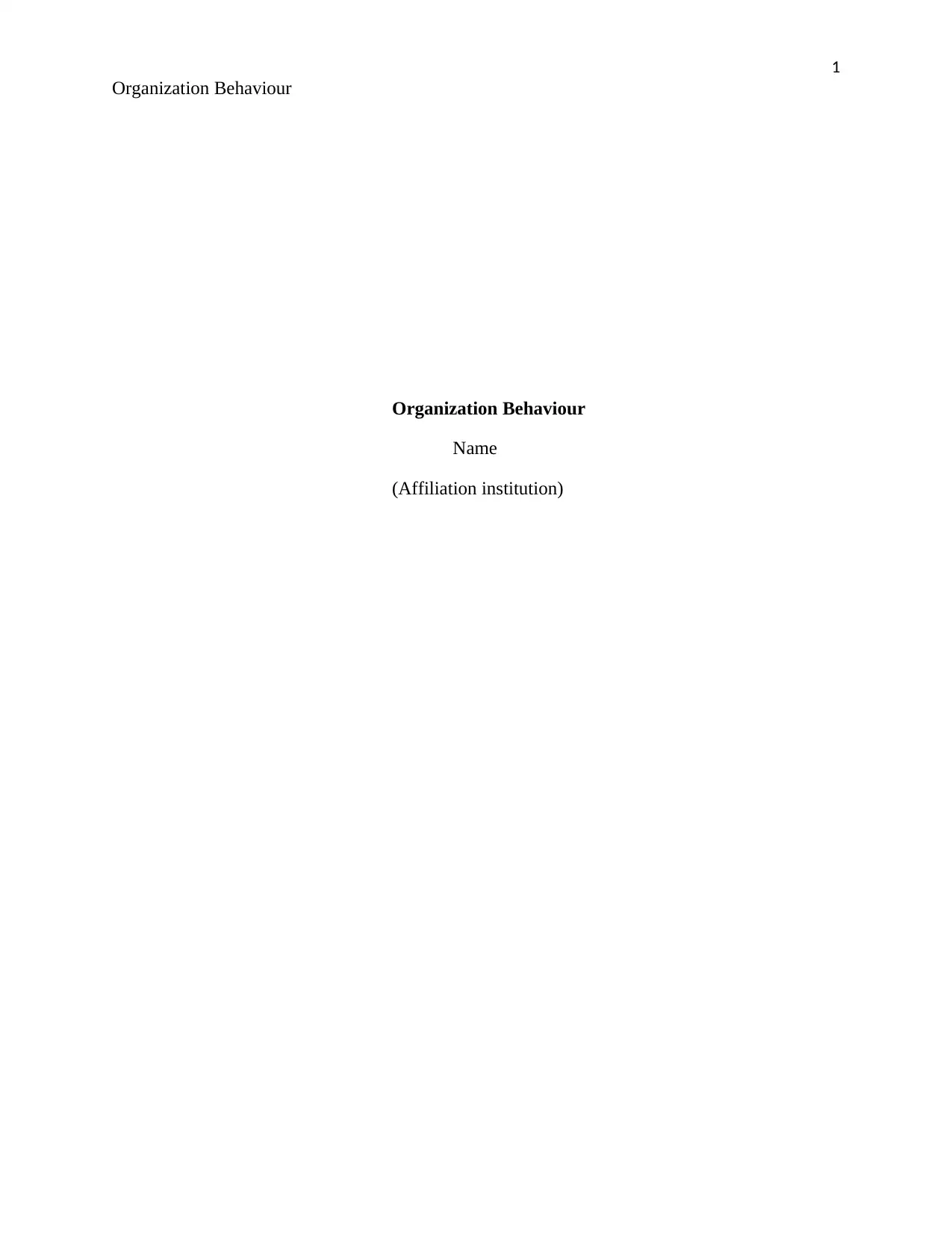
1
Organization Behaviour
Organization Behaviour
Name
(Affiliation institution)
Organization Behaviour
Organization Behaviour
Name
(Affiliation institution)
Paraphrase This Document
Need a fresh take? Get an instant paraphrase of this document with our AI Paraphraser
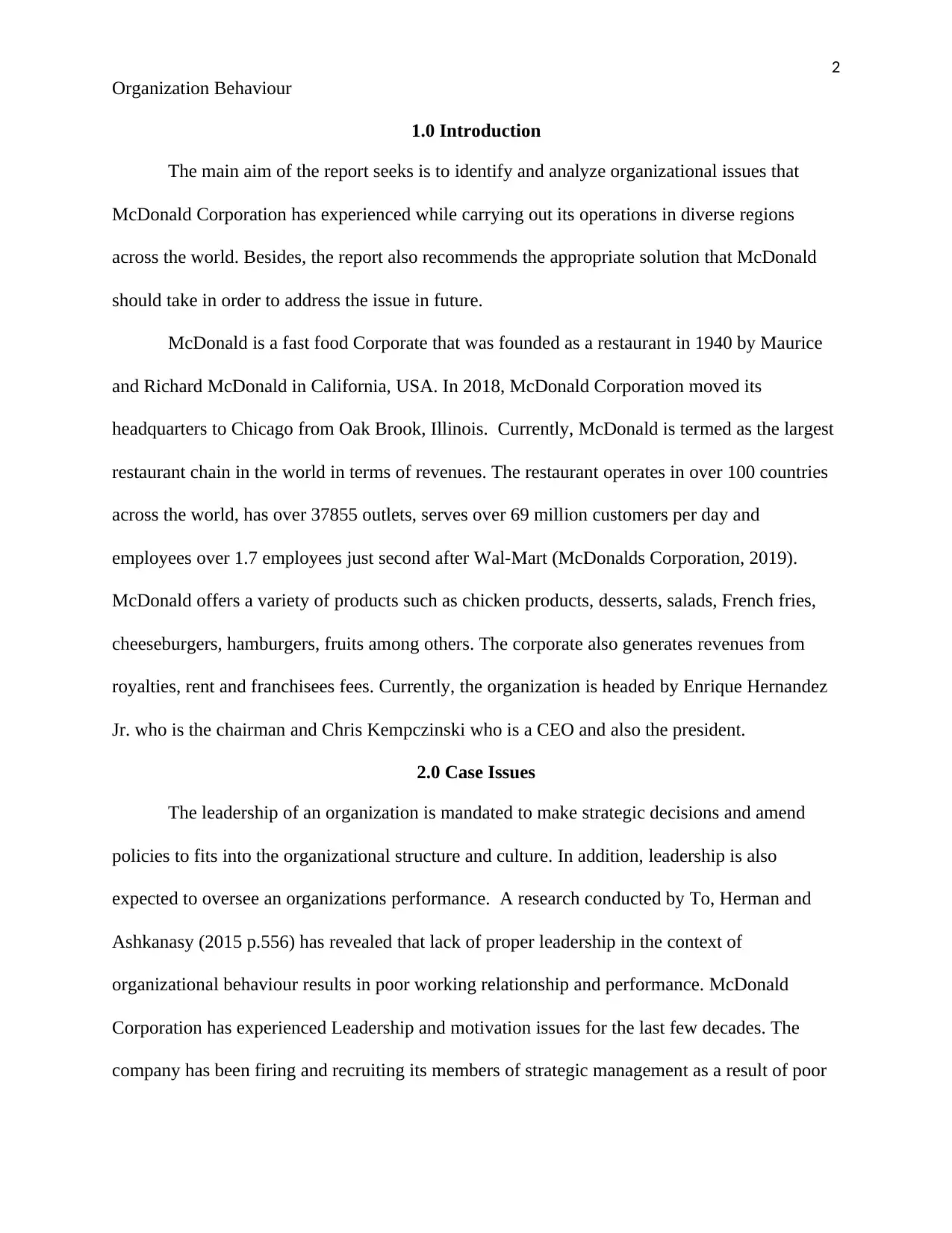
2
Organization Behaviour
1.0 Introduction
The main aim of the report seeks is to identify and analyze organizational issues that
McDonald Corporation has experienced while carrying out its operations in diverse regions
across the world. Besides, the report also recommends the appropriate solution that McDonald
should take in order to address the issue in future.
McDonald is a fast food Corporate that was founded as a restaurant in 1940 by Maurice
and Richard McDonald in California, USA. In 2018, McDonald Corporation moved its
headquarters to Chicago from Oak Brook, Illinois. Currently, McDonald is termed as the largest
restaurant chain in the world in terms of revenues. The restaurant operates in over 100 countries
across the world, has over 37855 outlets, serves over 69 million customers per day and
employees over 1.7 employees just second after Wal-Mart (McDonalds Corporation, 2019).
McDonald offers a variety of products such as chicken products, desserts, salads, French fries,
cheeseburgers, hamburgers, fruits among others. The corporate also generates revenues from
royalties, rent and franchisees fees. Currently, the organization is headed by Enrique Hernandez
Jr. who is the chairman and Chris Kempczinski who is a CEO and also the president.
2.0 Case Issues
The leadership of an organization is mandated to make strategic decisions and amend
policies to fits into the organizational structure and culture. In addition, leadership is also
expected to oversee an organizations performance. A research conducted by To, Herman and
Ashkanasy (2015 p.556) has revealed that lack of proper leadership in the context of
organizational behaviour results in poor working relationship and performance. McDonald
Corporation has experienced Leadership and motivation issues for the last few decades. The
company has been firing and recruiting its members of strategic management as a result of poor
Organization Behaviour
1.0 Introduction
The main aim of the report seeks is to identify and analyze organizational issues that
McDonald Corporation has experienced while carrying out its operations in diverse regions
across the world. Besides, the report also recommends the appropriate solution that McDonald
should take in order to address the issue in future.
McDonald is a fast food Corporate that was founded as a restaurant in 1940 by Maurice
and Richard McDonald in California, USA. In 2018, McDonald Corporation moved its
headquarters to Chicago from Oak Brook, Illinois. Currently, McDonald is termed as the largest
restaurant chain in the world in terms of revenues. The restaurant operates in over 100 countries
across the world, has over 37855 outlets, serves over 69 million customers per day and
employees over 1.7 employees just second after Wal-Mart (McDonalds Corporation, 2019).
McDonald offers a variety of products such as chicken products, desserts, salads, French fries,
cheeseburgers, hamburgers, fruits among others. The corporate also generates revenues from
royalties, rent and franchisees fees. Currently, the organization is headed by Enrique Hernandez
Jr. who is the chairman and Chris Kempczinski who is a CEO and also the president.
2.0 Case Issues
The leadership of an organization is mandated to make strategic decisions and amend
policies to fits into the organizational structure and culture. In addition, leadership is also
expected to oversee an organizations performance. A research conducted by To, Herman and
Ashkanasy (2015 p.556) has revealed that lack of proper leadership in the context of
organizational behaviour results in poor working relationship and performance. McDonald
Corporation has experienced Leadership and motivation issues for the last few decades. The
company has been firing and recruiting its members of strategic management as a result of poor
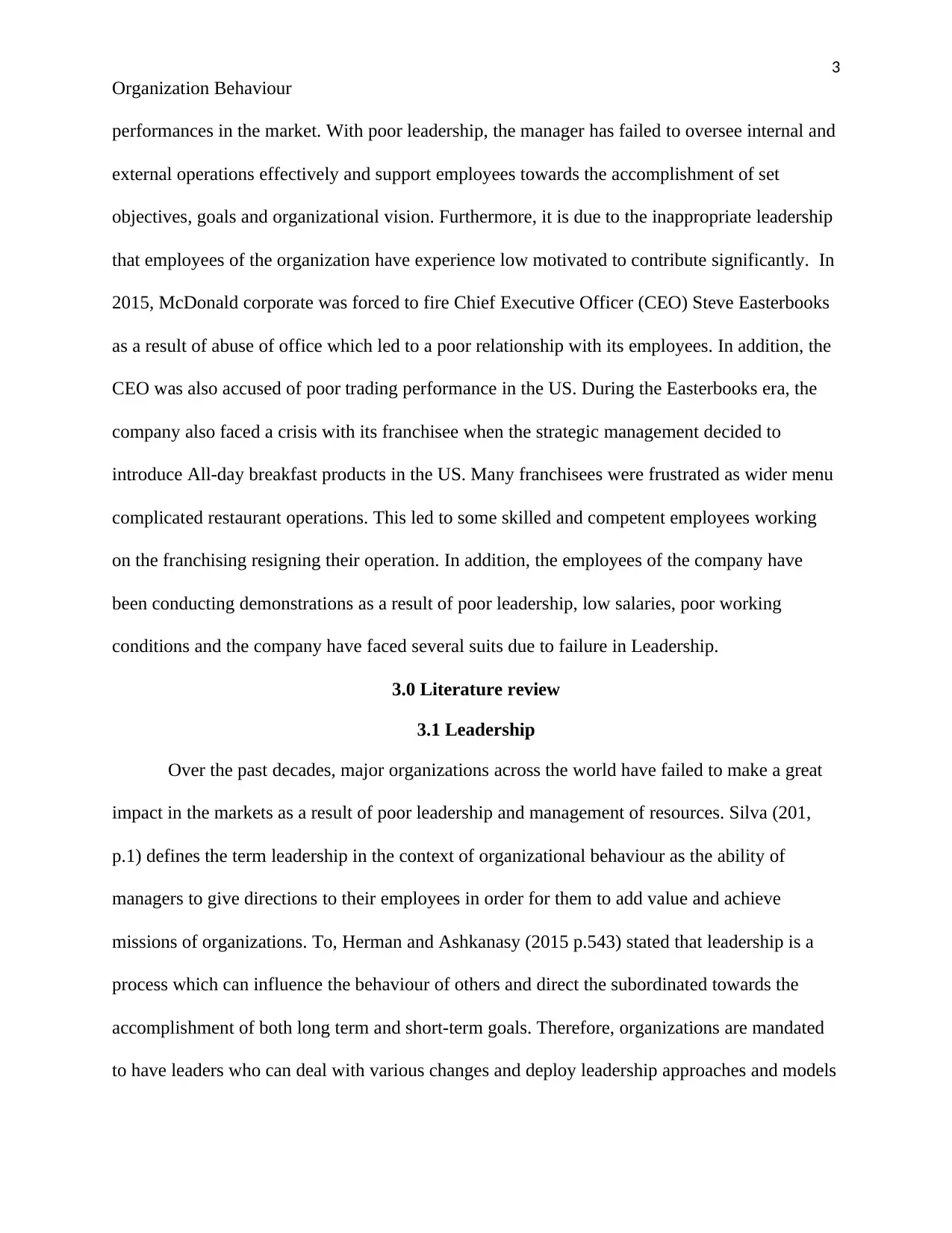
3
Organization Behaviour
performances in the market. With poor leadership, the manager has failed to oversee internal and
external operations effectively and support employees towards the accomplishment of set
objectives, goals and organizational vision. Furthermore, it is due to the inappropriate leadership
that employees of the organization have experience low motivated to contribute significantly. In
2015, McDonald corporate was forced to fire Chief Executive Officer (CEO) Steve Easterbooks
as a result of abuse of office which led to a poor relationship with its employees. In addition, the
CEO was also accused of poor trading performance in the US. During the Easterbooks era, the
company also faced a crisis with its franchisee when the strategic management decided to
introduce All-day breakfast products in the US. Many franchisees were frustrated as wider menu
complicated restaurant operations. This led to some skilled and competent employees working
on the franchising resigning their operation. In addition, the employees of the company have
been conducting demonstrations as a result of poor leadership, low salaries, poor working
conditions and the company have faced several suits due to failure in Leadership.
3.0 Literature review
3.1 Leadership
Over the past decades, major organizations across the world have failed to make a great
impact in the markets as a result of poor leadership and management of resources. Silva (201,
p.1) defines the term leadership in the context of organizational behaviour as the ability of
managers to give directions to their employees in order for them to add value and achieve
missions of organizations. To, Herman and Ashkanasy (2015 p.543) stated that leadership is a
process which can influence the behaviour of others and direct the subordinated towards the
accomplishment of both long term and short-term goals. Therefore, organizations are mandated
to have leaders who can deal with various changes and deploy leadership approaches and models
Organization Behaviour
performances in the market. With poor leadership, the manager has failed to oversee internal and
external operations effectively and support employees towards the accomplishment of set
objectives, goals and organizational vision. Furthermore, it is due to the inappropriate leadership
that employees of the organization have experience low motivated to contribute significantly. In
2015, McDonald corporate was forced to fire Chief Executive Officer (CEO) Steve Easterbooks
as a result of abuse of office which led to a poor relationship with its employees. In addition, the
CEO was also accused of poor trading performance in the US. During the Easterbooks era, the
company also faced a crisis with its franchisee when the strategic management decided to
introduce All-day breakfast products in the US. Many franchisees were frustrated as wider menu
complicated restaurant operations. This led to some skilled and competent employees working
on the franchising resigning their operation. In addition, the employees of the company have
been conducting demonstrations as a result of poor leadership, low salaries, poor working
conditions and the company have faced several suits due to failure in Leadership.
3.0 Literature review
3.1 Leadership
Over the past decades, major organizations across the world have failed to make a great
impact in the markets as a result of poor leadership and management of resources. Silva (201,
p.1) defines the term leadership in the context of organizational behaviour as the ability of
managers to give directions to their employees in order for them to add value and achieve
missions of organizations. To, Herman and Ashkanasy (2015 p.543) stated that leadership is a
process which can influence the behaviour of others and direct the subordinated towards the
accomplishment of both long term and short-term goals. Therefore, organizations are mandated
to have leaders who can deal with various changes and deploy leadership approaches and models
⊘ This is a preview!⊘
Do you want full access?
Subscribe today to unlock all pages.

Trusted by 1+ million students worldwide
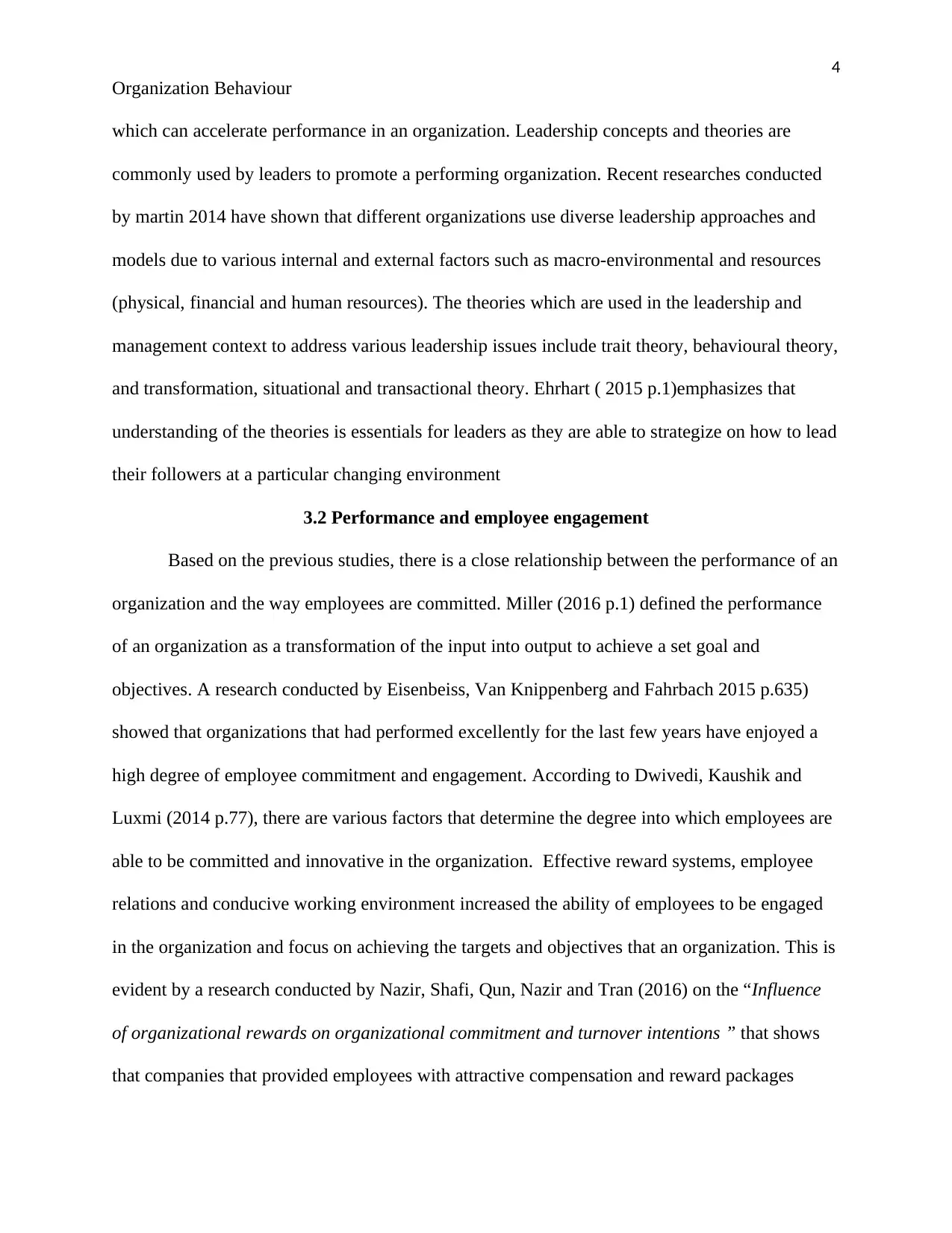
4
Organization Behaviour
which can accelerate performance in an organization. Leadership concepts and theories are
commonly used by leaders to promote a performing organization. Recent researches conducted
by martin 2014 have shown that different organizations use diverse leadership approaches and
models due to various internal and external factors such as macro-environmental and resources
(physical, financial and human resources). The theories which are used in the leadership and
management context to address various leadership issues include trait theory, behavioural theory,
and transformation, situational and transactional theory. Ehrhart ( 2015 p.1)emphasizes that
understanding of the theories is essentials for leaders as they are able to strategize on how to lead
their followers at a particular changing environment
3.2 Performance and employee engagement
Based on the previous studies, there is a close relationship between the performance of an
organization and the way employees are committed. Miller (2016 p.1) defined the performance
of an organization as a transformation of the input into output to achieve a set goal and
objectives. A research conducted by Eisenbeiss, Van Knippenberg and Fahrbach 2015 p.635)
showed that organizations that had performed excellently for the last few years have enjoyed a
high degree of employee commitment and engagement. According to Dwivedi, Kaushik and
Luxmi (2014 p.77), there are various factors that determine the degree into which employees are
able to be committed and innovative in the organization. Effective reward systems, employee
relations and conducive working environment increased the ability of employees to be engaged
in the organization and focus on achieving the targets and objectives that an organization. This is
evident by a research conducted by Nazir, Shafi, Qun, Nazir and Tran (2016) on the “Influence
of organizational rewards on organizational commitment and turnover intentions ” that shows
that companies that provided employees with attractive compensation and reward packages
Organization Behaviour
which can accelerate performance in an organization. Leadership concepts and theories are
commonly used by leaders to promote a performing organization. Recent researches conducted
by martin 2014 have shown that different organizations use diverse leadership approaches and
models due to various internal and external factors such as macro-environmental and resources
(physical, financial and human resources). The theories which are used in the leadership and
management context to address various leadership issues include trait theory, behavioural theory,
and transformation, situational and transactional theory. Ehrhart ( 2015 p.1)emphasizes that
understanding of the theories is essentials for leaders as they are able to strategize on how to lead
their followers at a particular changing environment
3.2 Performance and employee engagement
Based on the previous studies, there is a close relationship between the performance of an
organization and the way employees are committed. Miller (2016 p.1) defined the performance
of an organization as a transformation of the input into output to achieve a set goal and
objectives. A research conducted by Eisenbeiss, Van Knippenberg and Fahrbach 2015 p.635)
showed that organizations that had performed excellently for the last few years have enjoyed a
high degree of employee commitment and engagement. According to Dwivedi, Kaushik and
Luxmi (2014 p.77), there are various factors that determine the degree into which employees are
able to be committed and innovative in the organization. Effective reward systems, employee
relations and conducive working environment increased the ability of employees to be engaged
in the organization and focus on achieving the targets and objectives that an organization. This is
evident by a research conducted by Nazir, Shafi, Qun, Nazir and Tran (2016) on the “Influence
of organizational rewards on organizational commitment and turnover intentions ” that shows
that companies that provided employees with attractive compensation and reward packages
Paraphrase This Document
Need a fresh take? Get an instant paraphrase of this document with our AI Paraphraser
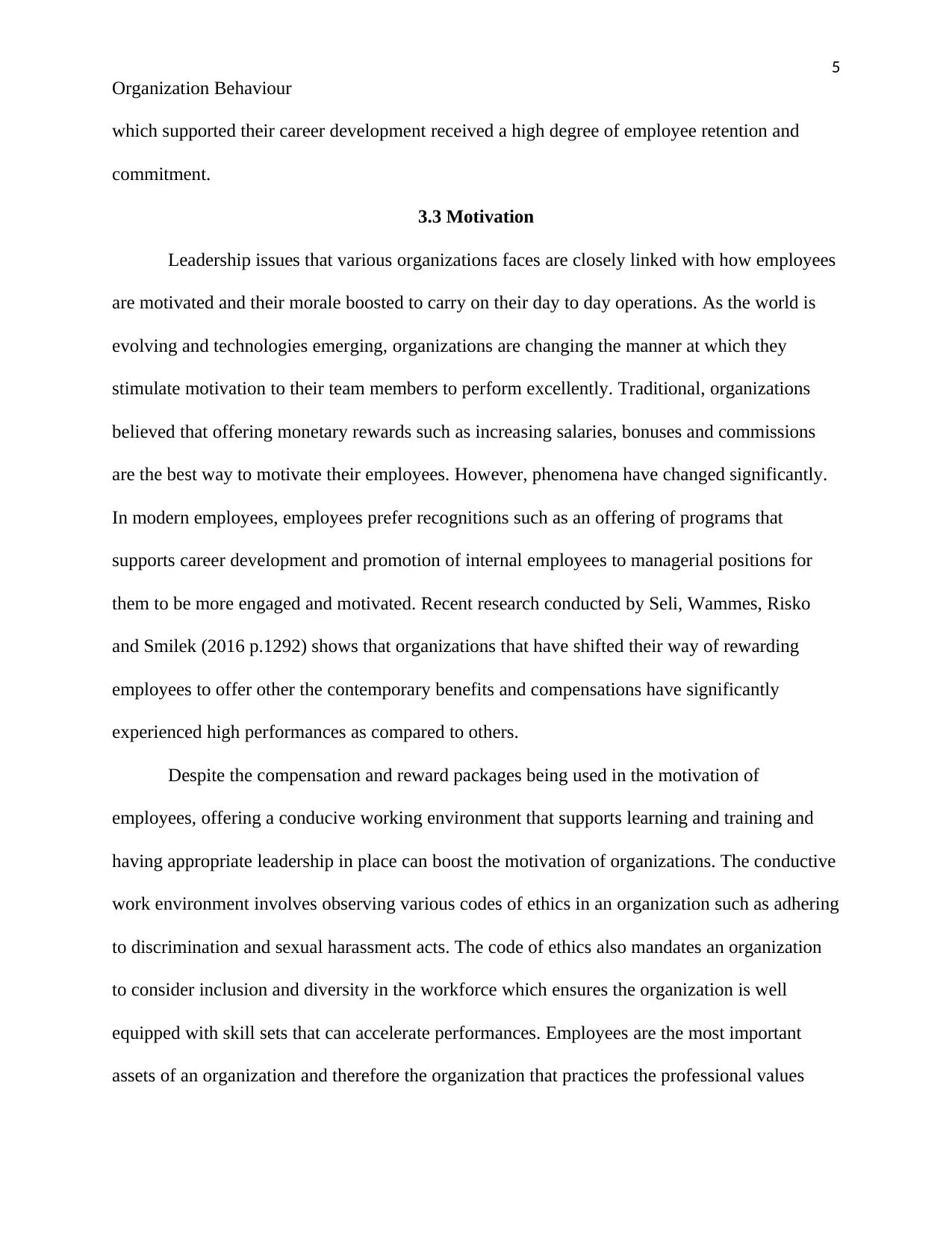
5
Organization Behaviour
which supported their career development received a high degree of employee retention and
commitment.
3.3 Motivation
Leadership issues that various organizations faces are closely linked with how employees
are motivated and their morale boosted to carry on their day to day operations. As the world is
evolving and technologies emerging, organizations are changing the manner at which they
stimulate motivation to their team members to perform excellently. Traditional, organizations
believed that offering monetary rewards such as increasing salaries, bonuses and commissions
are the best way to motivate their employees. However, phenomena have changed significantly.
In modern employees, employees prefer recognitions such as an offering of programs that
supports career development and promotion of internal employees to managerial positions for
them to be more engaged and motivated. Recent research conducted by Seli, Wammes, Risko
and Smilek (2016 p.1292) shows that organizations that have shifted their way of rewarding
employees to offer other the contemporary benefits and compensations have significantly
experienced high performances as compared to others.
Despite the compensation and reward packages being used in the motivation of
employees, offering a conducive working environment that supports learning and training and
having appropriate leadership in place can boost the motivation of organizations. The conductive
work environment involves observing various codes of ethics in an organization such as adhering
to discrimination and sexual harassment acts. The code of ethics also mandates an organization
to consider inclusion and diversity in the workforce which ensures the organization is well
equipped with skill sets that can accelerate performances. Employees are the most important
assets of an organization and therefore the organization that practices the professional values
Organization Behaviour
which supported their career development received a high degree of employee retention and
commitment.
3.3 Motivation
Leadership issues that various organizations faces are closely linked with how employees
are motivated and their morale boosted to carry on their day to day operations. As the world is
evolving and technologies emerging, organizations are changing the manner at which they
stimulate motivation to their team members to perform excellently. Traditional, organizations
believed that offering monetary rewards such as increasing salaries, bonuses and commissions
are the best way to motivate their employees. However, phenomena have changed significantly.
In modern employees, employees prefer recognitions such as an offering of programs that
supports career development and promotion of internal employees to managerial positions for
them to be more engaged and motivated. Recent research conducted by Seli, Wammes, Risko
and Smilek (2016 p.1292) shows that organizations that have shifted their way of rewarding
employees to offer other the contemporary benefits and compensations have significantly
experienced high performances as compared to others.
Despite the compensation and reward packages being used in the motivation of
employees, offering a conducive working environment that supports learning and training and
having appropriate leadership in place can boost the motivation of organizations. The conductive
work environment involves observing various codes of ethics in an organization such as adhering
to discrimination and sexual harassment acts. The code of ethics also mandates an organization
to consider inclusion and diversity in the workforce which ensures the organization is well
equipped with skill sets that can accelerate performances. Employees are the most important
assets of an organization and therefore the organization that practices the professional values
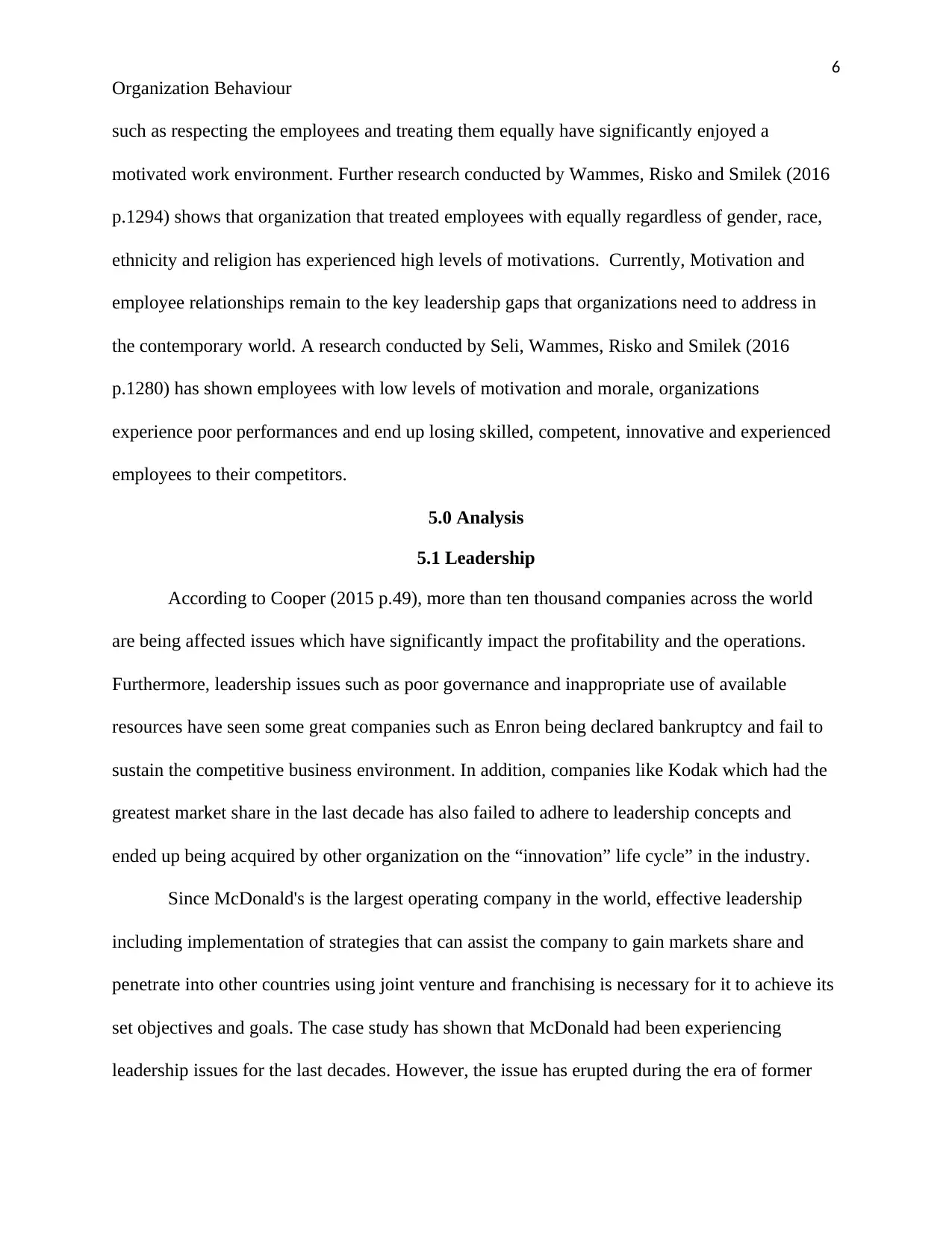
6
Organization Behaviour
such as respecting the employees and treating them equally have significantly enjoyed a
motivated work environment. Further research conducted by Wammes, Risko and Smilek (2016
p.1294) shows that organization that treated employees with equally regardless of gender, race,
ethnicity and religion has experienced high levels of motivations. Currently, Motivation and
employee relationships remain to the key leadership gaps that organizations need to address in
the contemporary world. A research conducted by Seli, Wammes, Risko and Smilek (2016
p.1280) has shown employees with low levels of motivation and morale, organizations
experience poor performances and end up losing skilled, competent, innovative and experienced
employees to their competitors.
5.0 Analysis
5.1 Leadership
According to Cooper (2015 p.49), more than ten thousand companies across the world
are being affected issues which have significantly impact the profitability and the operations.
Furthermore, leadership issues such as poor governance and inappropriate use of available
resources have seen some great companies such as Enron being declared bankruptcy and fail to
sustain the competitive business environment. In addition, companies like Kodak which had the
greatest market share in the last decade has also failed to adhere to leadership concepts and
ended up being acquired by other organization on the “innovation” life cycle” in the industry.
Since McDonald's is the largest operating company in the world, effective leadership
including implementation of strategies that can assist the company to gain markets share and
penetrate into other countries using joint venture and franchising is necessary for it to achieve its
set objectives and goals. The case study has shown that McDonald had been experiencing
leadership issues for the last decades. However, the issue has erupted during the era of former
Organization Behaviour
such as respecting the employees and treating them equally have significantly enjoyed a
motivated work environment. Further research conducted by Wammes, Risko and Smilek (2016
p.1294) shows that organization that treated employees with equally regardless of gender, race,
ethnicity and religion has experienced high levels of motivations. Currently, Motivation and
employee relationships remain to the key leadership gaps that organizations need to address in
the contemporary world. A research conducted by Seli, Wammes, Risko and Smilek (2016
p.1280) has shown employees with low levels of motivation and morale, organizations
experience poor performances and end up losing skilled, competent, innovative and experienced
employees to their competitors.
5.0 Analysis
5.1 Leadership
According to Cooper (2015 p.49), more than ten thousand companies across the world
are being affected issues which have significantly impact the profitability and the operations.
Furthermore, leadership issues such as poor governance and inappropriate use of available
resources have seen some great companies such as Enron being declared bankruptcy and fail to
sustain the competitive business environment. In addition, companies like Kodak which had the
greatest market share in the last decade has also failed to adhere to leadership concepts and
ended up being acquired by other organization on the “innovation” life cycle” in the industry.
Since McDonald's is the largest operating company in the world, effective leadership
including implementation of strategies that can assist the company to gain markets share and
penetrate into other countries using joint venture and franchising is necessary for it to achieve its
set objectives and goals. The case study has shown that McDonald had been experiencing
leadership issues for the last decades. However, the issue has erupted during the era of former
⊘ This is a preview!⊘
Do you want full access?
Subscribe today to unlock all pages.

Trusted by 1+ million students worldwide
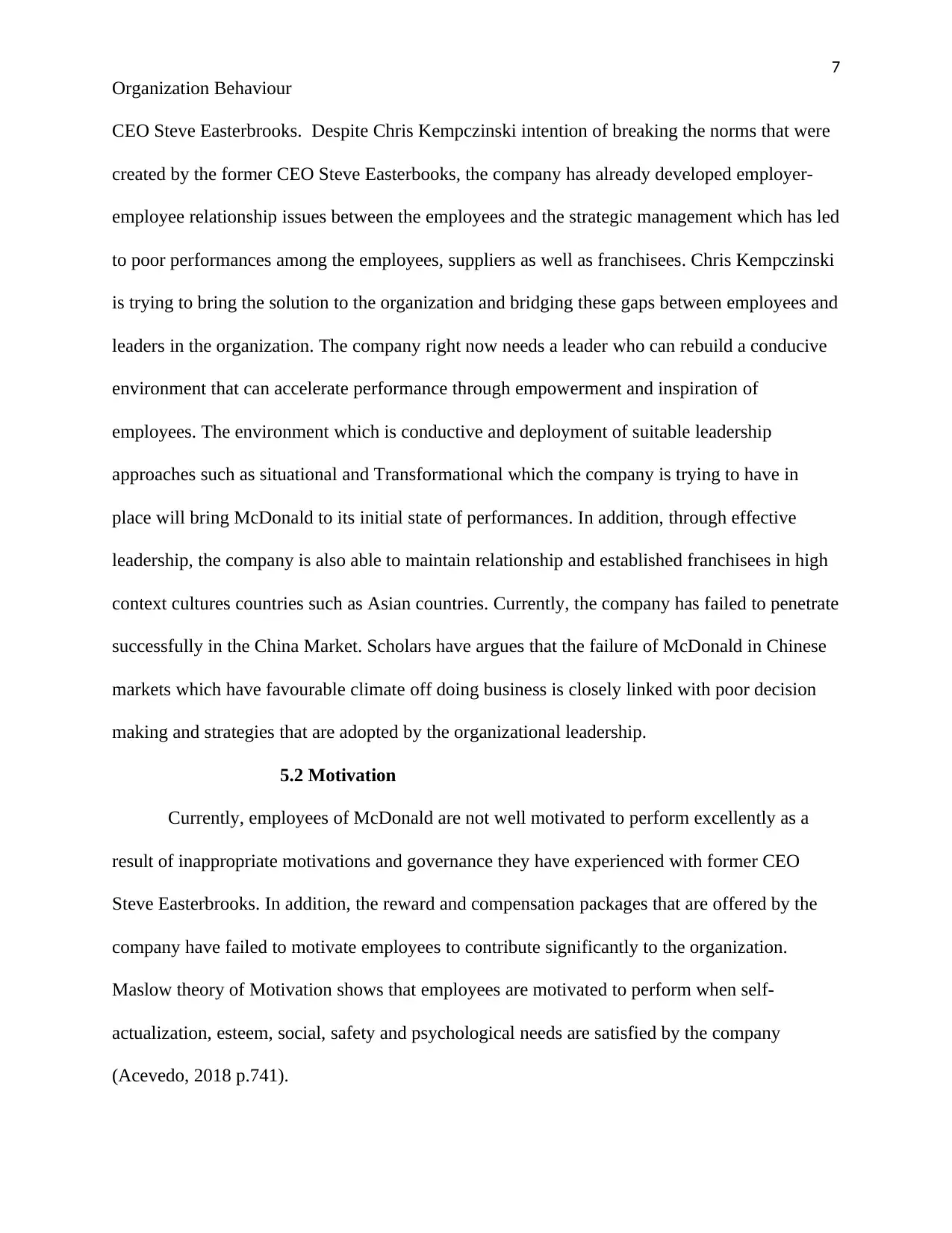
7
Organization Behaviour
CEO Steve Easterbrooks. Despite Chris Kempczinski intention of breaking the norms that were
created by the former CEO Steve Easterbooks, the company has already developed employer-
employee relationship issues between the employees and the strategic management which has led
to poor performances among the employees, suppliers as well as franchisees. Chris Kempczinski
is trying to bring the solution to the organization and bridging these gaps between employees and
leaders in the organization. The company right now needs a leader who can rebuild a conducive
environment that can accelerate performance through empowerment and inspiration of
employees. The environment which is conductive and deployment of suitable leadership
approaches such as situational and Transformational which the company is trying to have in
place will bring McDonald to its initial state of performances. In addition, through effective
leadership, the company is also able to maintain relationship and established franchisees in high
context cultures countries such as Asian countries. Currently, the company has failed to penetrate
successfully in the China Market. Scholars have argues that the failure of McDonald in Chinese
markets which have favourable climate off doing business is closely linked with poor decision
making and strategies that are adopted by the organizational leadership.
5.2 Motivation
Currently, employees of McDonald are not well motivated to perform excellently as a
result of inappropriate motivations and governance they have experienced with former CEO
Steve Easterbrooks. In addition, the reward and compensation packages that are offered by the
company have failed to motivate employees to contribute significantly to the organization.
Maslow theory of Motivation shows that employees are motivated to perform when self-
actualization, esteem, social, safety and psychological needs are satisfied by the company
(Acevedo, 2018 p.741).
Organization Behaviour
CEO Steve Easterbrooks. Despite Chris Kempczinski intention of breaking the norms that were
created by the former CEO Steve Easterbooks, the company has already developed employer-
employee relationship issues between the employees and the strategic management which has led
to poor performances among the employees, suppliers as well as franchisees. Chris Kempczinski
is trying to bring the solution to the organization and bridging these gaps between employees and
leaders in the organization. The company right now needs a leader who can rebuild a conducive
environment that can accelerate performance through empowerment and inspiration of
employees. The environment which is conductive and deployment of suitable leadership
approaches such as situational and Transformational which the company is trying to have in
place will bring McDonald to its initial state of performances. In addition, through effective
leadership, the company is also able to maintain relationship and established franchisees in high
context cultures countries such as Asian countries. Currently, the company has failed to penetrate
successfully in the China Market. Scholars have argues that the failure of McDonald in Chinese
markets which have favourable climate off doing business is closely linked with poor decision
making and strategies that are adopted by the organizational leadership.
5.2 Motivation
Currently, employees of McDonald are not well motivated to perform excellently as a
result of inappropriate motivations and governance they have experienced with former CEO
Steve Easterbrooks. In addition, the reward and compensation packages that are offered by the
company have failed to motivate employees to contribute significantly to the organization.
Maslow theory of Motivation shows that employees are motivated to perform when self-
actualization, esteem, social, safety and psychological needs are satisfied by the company
(Acevedo, 2018 p.741).
Paraphrase This Document
Need a fresh take? Get an instant paraphrase of this document with our AI Paraphraser
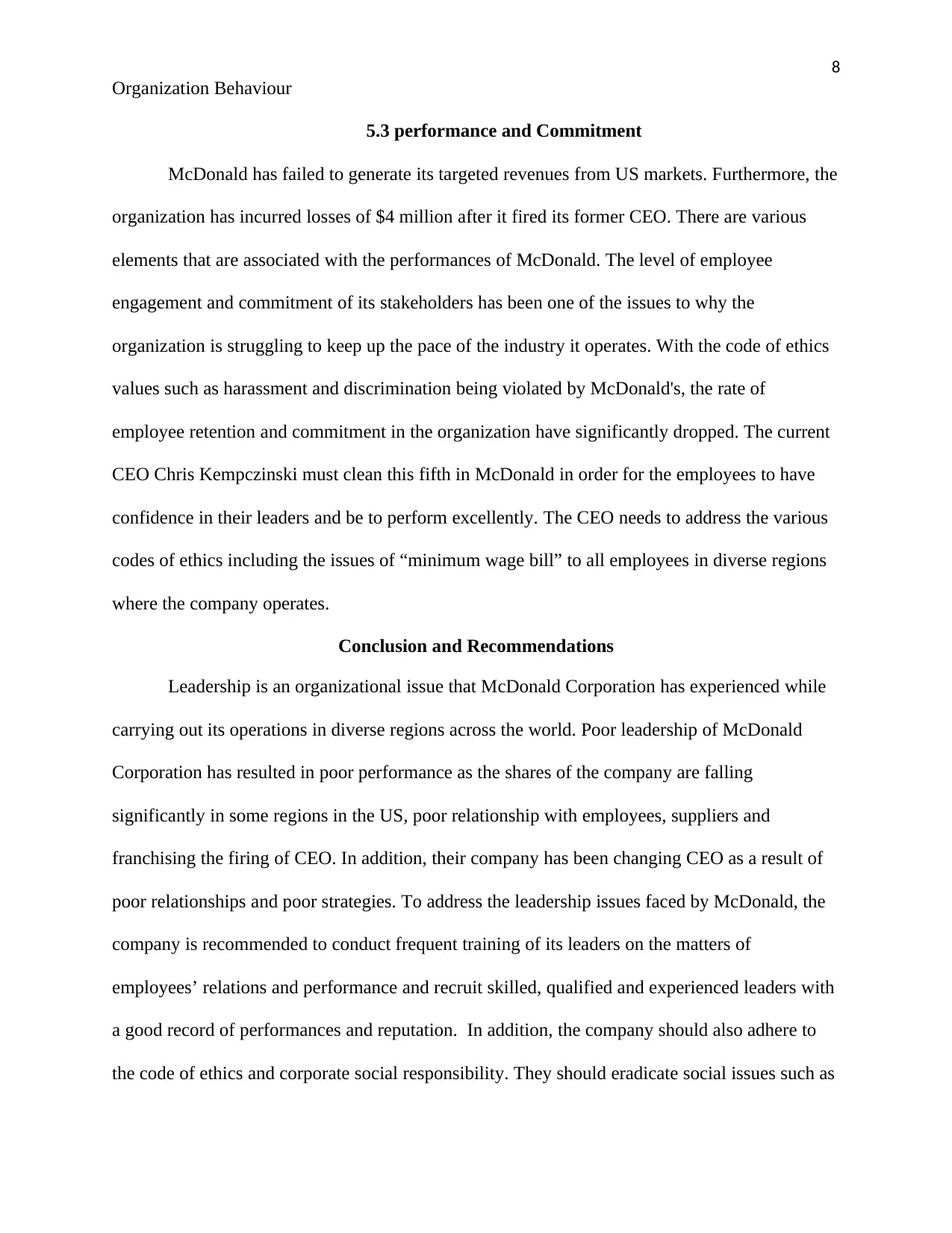
8
Organization Behaviour
5.3 performance and Commitment
McDonald has failed to generate its targeted revenues from US markets. Furthermore, the
organization has incurred losses of $4 million after it fired its former CEO. There are various
elements that are associated with the performances of McDonald. The level of employee
engagement and commitment of its stakeholders has been one of the issues to why the
organization is struggling to keep up the pace of the industry it operates. With the code of ethics
values such as harassment and discrimination being violated by McDonald's, the rate of
employee retention and commitment in the organization have significantly dropped. The current
CEO Chris Kempczinski must clean this fifth in McDonald in order for the employees to have
confidence in their leaders and be to perform excellently. The CEO needs to address the various
codes of ethics including the issues of “minimum wage bill” to all employees in diverse regions
where the company operates.
Conclusion and Recommendations
Leadership is an organizational issue that McDonald Corporation has experienced while
carrying out its operations in diverse regions across the world. Poor leadership of McDonald
Corporation has resulted in poor performance as the shares of the company are falling
significantly in some regions in the US, poor relationship with employees, suppliers and
franchising the firing of CEO. In addition, their company has been changing CEO as a result of
poor relationships and poor strategies. To address the leadership issues faced by McDonald, the
company is recommended to conduct frequent training of its leaders on the matters of
employees’ relations and performance and recruit skilled, qualified and experienced leaders with
a good record of performances and reputation. In addition, the company should also adhere to
the code of ethics and corporate social responsibility. They should eradicate social issues such as
Organization Behaviour
5.3 performance and Commitment
McDonald has failed to generate its targeted revenues from US markets. Furthermore, the
organization has incurred losses of $4 million after it fired its former CEO. There are various
elements that are associated with the performances of McDonald. The level of employee
engagement and commitment of its stakeholders has been one of the issues to why the
organization is struggling to keep up the pace of the industry it operates. With the code of ethics
values such as harassment and discrimination being violated by McDonald's, the rate of
employee retention and commitment in the organization have significantly dropped. The current
CEO Chris Kempczinski must clean this fifth in McDonald in order for the employees to have
confidence in their leaders and be to perform excellently. The CEO needs to address the various
codes of ethics including the issues of “minimum wage bill” to all employees in diverse regions
where the company operates.
Conclusion and Recommendations
Leadership is an organizational issue that McDonald Corporation has experienced while
carrying out its operations in diverse regions across the world. Poor leadership of McDonald
Corporation has resulted in poor performance as the shares of the company are falling
significantly in some regions in the US, poor relationship with employees, suppliers and
franchising the firing of CEO. In addition, their company has been changing CEO as a result of
poor relationships and poor strategies. To address the leadership issues faced by McDonald, the
company is recommended to conduct frequent training of its leaders on the matters of
employees’ relations and performance and recruit skilled, qualified and experienced leaders with
a good record of performances and reputation. In addition, the company should also adhere to
the code of ethics and corporate social responsibility. They should eradicate social issues such as
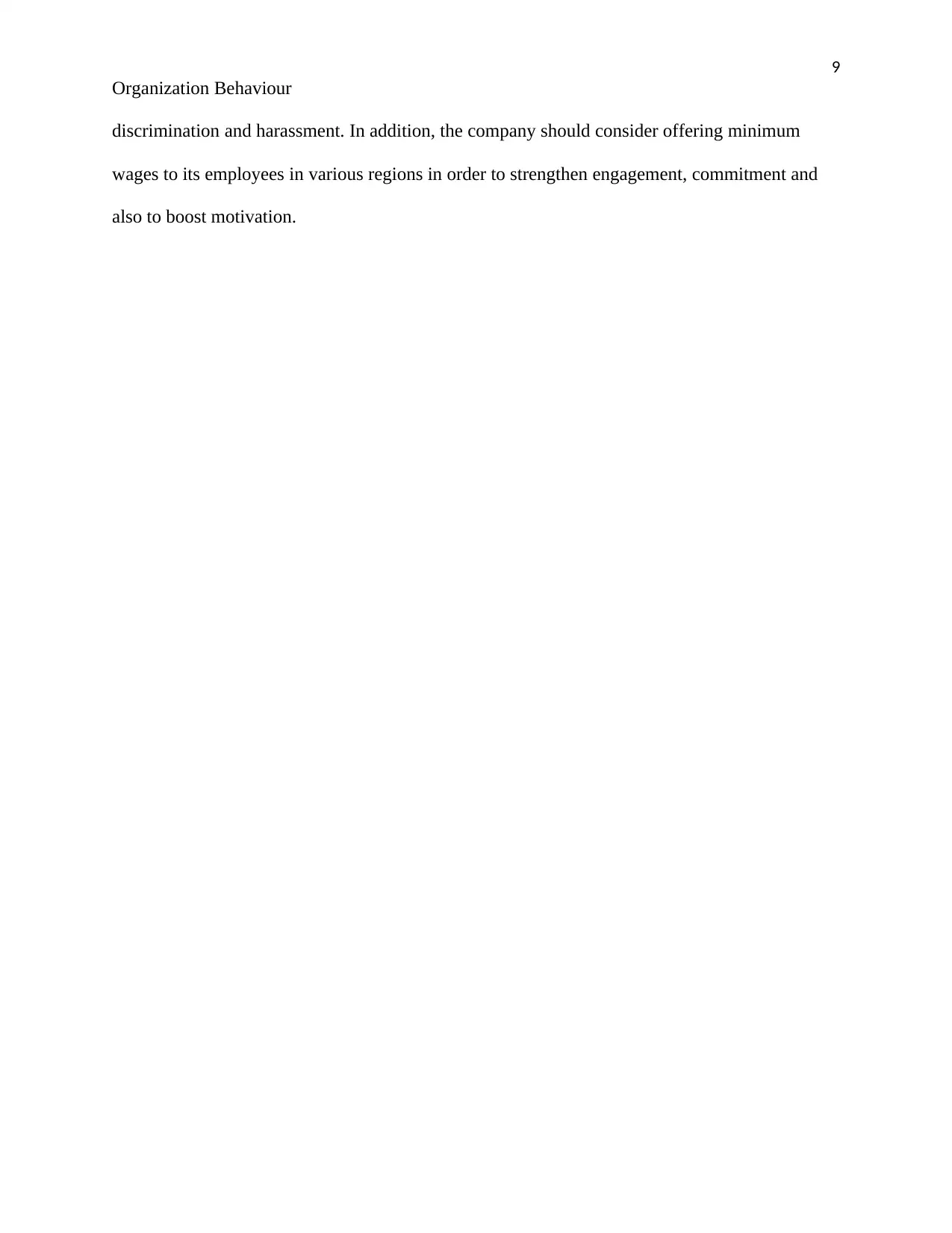
9
Organization Behaviour
discrimination and harassment. In addition, the company should consider offering minimum
wages to its employees in various regions in order to strengthen engagement, commitment and
also to boost motivation.
Organization Behaviour
discrimination and harassment. In addition, the company should consider offering minimum
wages to its employees in various regions in order to strengthen engagement, commitment and
also to boost motivation.
⊘ This is a preview!⊘
Do you want full access?
Subscribe today to unlock all pages.

Trusted by 1+ million students worldwide
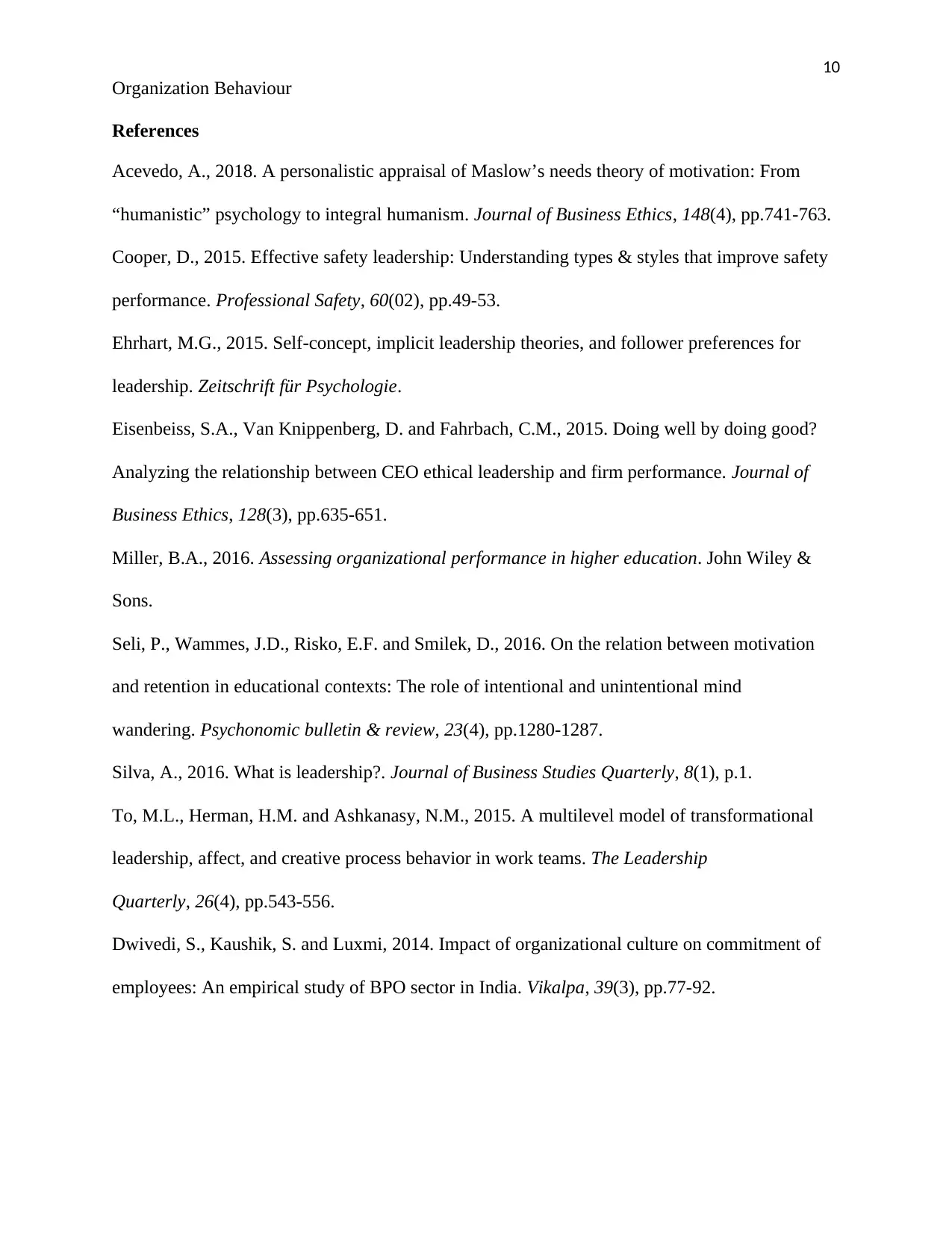
10
Organization Behaviour
References
Acevedo, A., 2018. A personalistic appraisal of Maslow’s needs theory of motivation: From
“humanistic” psychology to integral humanism. Journal of Business Ethics, 148(4), pp.741-763.
Cooper, D., 2015. Effective safety leadership: Understanding types & styles that improve safety
performance. Professional Safety, 60(02), pp.49-53.
Ehrhart, M.G., 2015. Self-concept, implicit leadership theories, and follower preferences for
leadership. Zeitschrift für Psychologie.
Eisenbeiss, S.A., Van Knippenberg, D. and Fahrbach, C.M., 2015. Doing well by doing good?
Analyzing the relationship between CEO ethical leadership and firm performance. Journal of
Business Ethics, 128(3), pp.635-651.
Miller, B.A., 2016. Assessing organizational performance in higher education. John Wiley &
Sons.
Seli, P., Wammes, J.D., Risko, E.F. and Smilek, D., 2016. On the relation between motivation
and retention in educational contexts: The role of intentional and unintentional mind
wandering. Psychonomic bulletin & review, 23(4), pp.1280-1287.
Silva, A., 2016. What is leadership?. Journal of Business Studies Quarterly, 8(1), p.1.
To, M.L., Herman, H.M. and Ashkanasy, N.M., 2015. A multilevel model of transformational
leadership, affect, and creative process behavior in work teams. The Leadership
Quarterly, 26(4), pp.543-556.
Dwivedi, S., Kaushik, S. and Luxmi, 2014. Impact of organizational culture on commitment of
employees: An empirical study of BPO sector in India. Vikalpa, 39(3), pp.77-92.
Organization Behaviour
References
Acevedo, A., 2018. A personalistic appraisal of Maslow’s needs theory of motivation: From
“humanistic” psychology to integral humanism. Journal of Business Ethics, 148(4), pp.741-763.
Cooper, D., 2015. Effective safety leadership: Understanding types & styles that improve safety
performance. Professional Safety, 60(02), pp.49-53.
Ehrhart, M.G., 2015. Self-concept, implicit leadership theories, and follower preferences for
leadership. Zeitschrift für Psychologie.
Eisenbeiss, S.A., Van Knippenberg, D. and Fahrbach, C.M., 2015. Doing well by doing good?
Analyzing the relationship between CEO ethical leadership and firm performance. Journal of
Business Ethics, 128(3), pp.635-651.
Miller, B.A., 2016. Assessing organizational performance in higher education. John Wiley &
Sons.
Seli, P., Wammes, J.D., Risko, E.F. and Smilek, D., 2016. On the relation between motivation
and retention in educational contexts: The role of intentional and unintentional mind
wandering. Psychonomic bulletin & review, 23(4), pp.1280-1287.
Silva, A., 2016. What is leadership?. Journal of Business Studies Quarterly, 8(1), p.1.
To, M.L., Herman, H.M. and Ashkanasy, N.M., 2015. A multilevel model of transformational
leadership, affect, and creative process behavior in work teams. The Leadership
Quarterly, 26(4), pp.543-556.
Dwivedi, S., Kaushik, S. and Luxmi, 2014. Impact of organizational culture on commitment of
employees: An empirical study of BPO sector in India. Vikalpa, 39(3), pp.77-92.
Paraphrase This Document
Need a fresh take? Get an instant paraphrase of this document with our AI Paraphraser
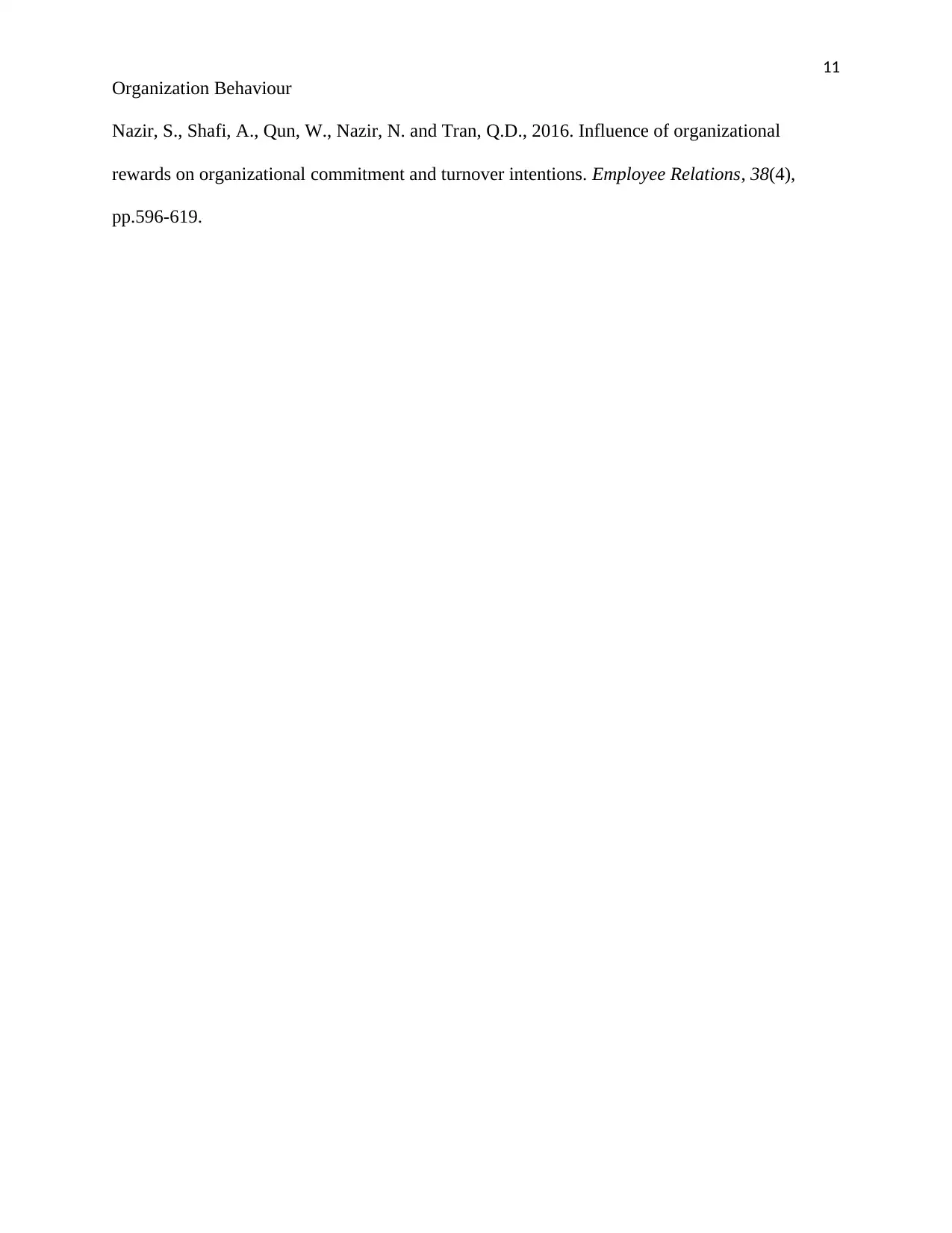
11
Organization Behaviour
Nazir, S., Shafi, A., Qun, W., Nazir, N. and Tran, Q.D., 2016. Influence of organizational
rewards on organizational commitment and turnover intentions. Employee Relations, 38(4),
pp.596-619.
Organization Behaviour
Nazir, S., Shafi, A., Qun, W., Nazir, N. and Tran, Q.D., 2016. Influence of organizational
rewards on organizational commitment and turnover intentions. Employee Relations, 38(4),
pp.596-619.
1 out of 11
Related Documents
Your All-in-One AI-Powered Toolkit for Academic Success.
+13062052269
info@desklib.com
Available 24*7 on WhatsApp / Email
![[object Object]](/_next/static/media/star-bottom.7253800d.svg)
Unlock your academic potential
Copyright © 2020–2025 A2Z Services. All Rights Reserved. Developed and managed by ZUCOL.





